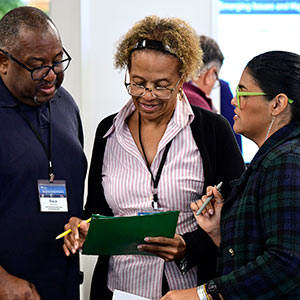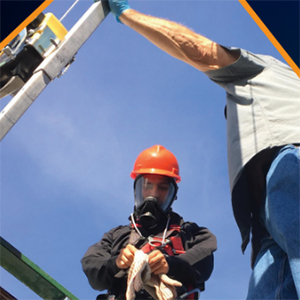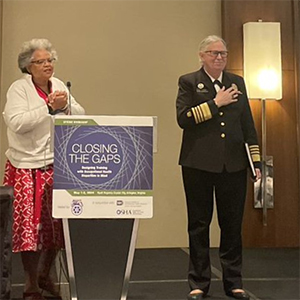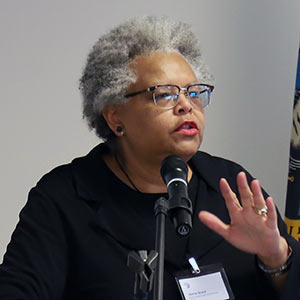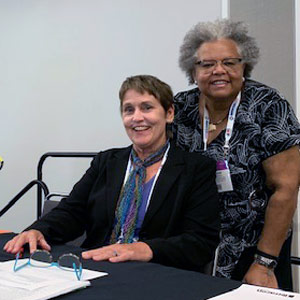 Rick Woychik, Ph.D., directs NIEHS and the National Toxicology Program. (Image courtesy of NIEHS)
Rick Woychik, Ph.D., directs NIEHS and the National Toxicology Program. (Image courtesy of NIEHS)In 2021, Sharon Beard was appointed director of the NIEHS Worker Training Program (WTP), bringing decades of valuable experience and leadership skills to her new role. She is preceded by Joseph “Chip” Hughes, who left WTP to become Deputy Assistant Secretary for Pandemic and Emergency Response in the Occupational Safety and Health Administration (OSHA).
Mrs. Beard led the institute’s Environmental Career Worker Training Program (ECWTP) for more than 25 years (ECWTP previously was called the Minority Worker Training Program). That position required collaboration-building, long-term strategic thinking, and a deep understanding of both the job-related and socioeconomic challenges faced by workers involved in hazardous waste removal, disaster response, and related projects.
 Beard is a member of the American Public Health Association and the American Conference of Governmental Industrial Hygienists. (Photo courtesy of Sharon Beard / NIEHS)
Beard is a member of the American Public Health Association and the American Conference of Governmental Industrial Hygienists. (Photo courtesy of Sharon Beard / NIEHS)An industrial hygienist by training, Mrs. Beard is regarded as a national leader in the field. She received the 2021 Rachel Carson Award from the American Industrial Hygiene Association based on her outstanding work in environmental and industrial health and safety. In 2013, she earned the prestigious Lorin Kerr Award from the American Public Health Association, which recognized Beard for her efforts to develop effective training programs for low-income workers.
She brings her expertise to bear on the day-to-day management of WTP. The organization funds longstanding cooperative agreements and grants aimed at training individuals on how stay safe in hazardous work environments, and that requires collaboration with stakeholders and partners across the country. Mrs. Beard also focuses on issues related to environmental justice(https://tools.niehs.nih.gov/wetp/?id=13). Her leadership priorities are informed by her understanding of how disadvantaged individuals — whether due to factors such as place, race, or income — are often most vulnerable to natural disasters, the negative health effects of climate change, and other environmental challenges.
For example, Mrs. Beard serves on the NIEHS Environmental Health Disparities and Environmental Justice Faculty and the White House Environmental Justice Interagency Advisory Council. She also is helping to advance the Justice40 Initiative, an effort led by the Biden administration that aims to ensure that 40% of federal investments in clean energy benefit disadvantaged communities.
Recently, I spoke with Mrs. Beard to learn more about her efforts at WTP and what motivated her to pursue a career in industrial hygiene, specifically in the field of environmental worker health and safety (see first sidebar). One thing that stood out from our conversation is that she is passionate about translating research regarding environmental and occupational hazards into easy-to-understand, actionable advice for workers facing potentially harmful exposures.
Hazardous materials, disasters, and infectious diseases
Rick Woychik: Can you describe the history of WTP for Environmental Factor readers?
Sharon Beard: Sure. Our program was created in 1986, after Congress passed the Superfund Amendments and Reauthorization Act. We are what I like to call the applied arm of NIEHS. We take the research, translate it, and develop training and tools to make sure that workers and volunteers involved with hazardous materials, disaster response, and environmental cleanup understand potential health risks and how to protect themselves while they do their jobs.
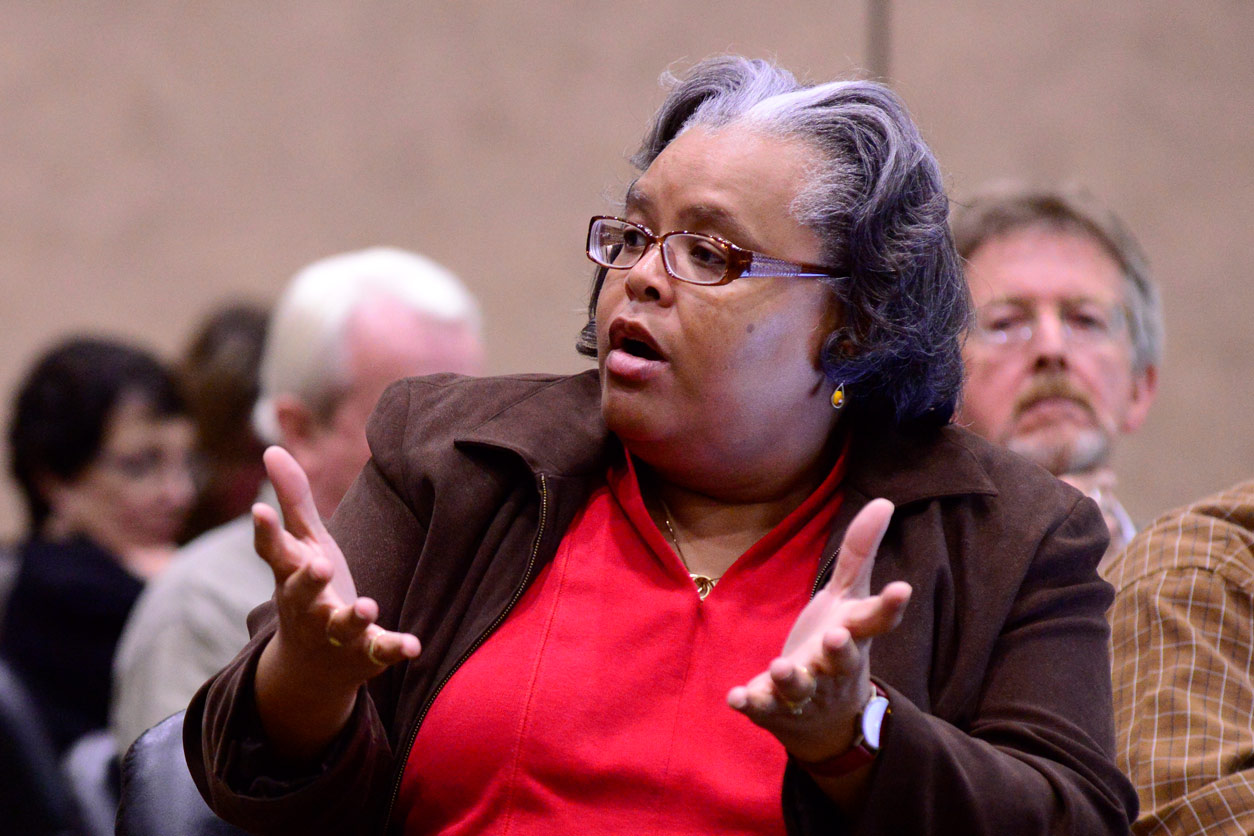 Beard, shown here at a 2014 WTP meeting, earned a master’s degree in environmental science and management from Tufts University. (Photo courtesy of Steve McCaw / NIEHS)
Beard, shown here at a 2014 WTP meeting, earned a master’s degree in environmental science and management from Tufts University. (Photo courtesy of Steve McCaw / NIEHS)
We build partnerships with our grantees — labor organizations, nonprofit groups, and educational institutions, among others — to create hands-on worker training. Initially, we focused on hazardous materials training, but we have expanded. For example, WTP now includes ECWTP, which helps disadvantaged workers gain valuable job and life skills; a collaboration with the U.S. Department of Energy to train individuals at nuclear facilities; and safety education related to infectious diseases such as Ebola and, more recently, COVID-19.
Organizations we partner with — whether we’re talking about the Center for Construction Research and Training; nonprofits that focus on vulnerable populations; or a group like OAI, Inc., which works with underrepresented and diverse worker populations — are invaluable in terms of building community trust and advancing worker health and safety. WTP supports a variety of programs across the U.S., and we have been involved in all kinds of emergency response activities, from 9/11 and major oil spills to climate-related disasters such as hurricanes, wildfires, and floods.
Also, we have sought to develop training that is appropriate for the target population. We promote what I call language justice, where if we are training individuals for whom English is their second language, our materials are presented in their first language because is that is how you increase understanding of the educational content. We also utilize peer-to-peer training, so if we are talking about a carpenter, he or she masters the content and then shares that knowledge with other carpenters. This is all about effective communication and engagement and ensuring that the training developed by our grantees has maximum impact.
I should add that WTP also created the National Clearinghouse for Worker Safety and Health Training, which has been integral in terms of providing our grantees with curricula, safety protocols, technical reports, and relevant news in the world of worker training.
Helping disadvantaged communities thrive
RW: You mentioned ECWTP, which you have been involved with since its inception in 1995. Can you talk a little bit about the success of that program and how you are building on that success to help advance President Biden’s Justice40 Initiative?
SB: One thing that I learned from my work with environmental justice communities when I was in graduate school at Tufts University is that collaboration is key. When I arrived at NIEHS, the program focused primarily on partnering with major construction organizations, and we hadn't really branched out to develop more partnerships. So, I focused on trying to bring all the players to the table so that ECWTP could be more successful in terms of helping the unemployed, the underemployed, homeless people, individuals who perhaps had been incarcerated, and so forth.
The idea was to create a win-win situation where our grantees built effective training programs and participants gained skills necessary to be productive members of their communities. We connected with community colleges, historically black colleges and universities, apprenticeship programs, and various nonprofits to truly transform ECWTP and bring about phenomenal results.
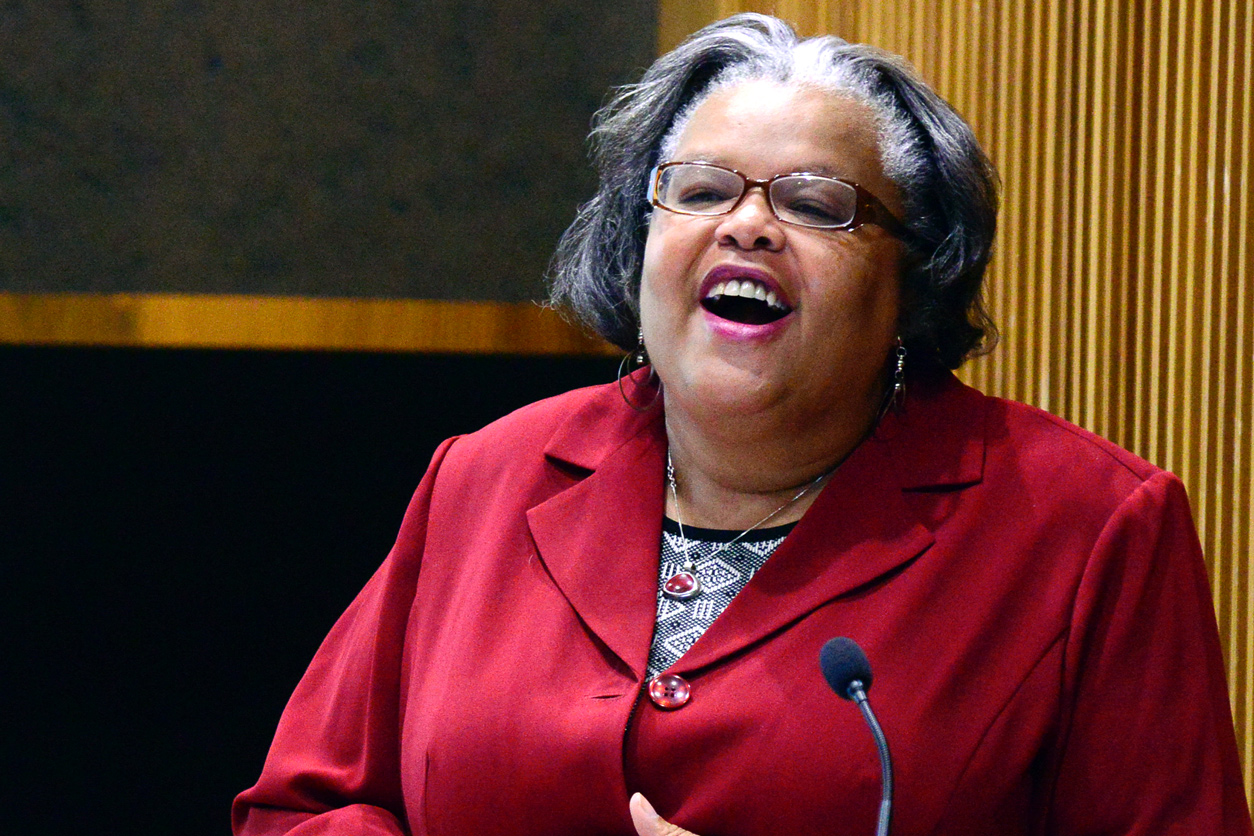 Shown here at a 2015 WTP meeting, Beard is a skilled team builder who is a perfect fit to lead WTP, where collaboration and partnerships are so critical. (Photo courtesy of Steve McCaw / NIEHS)
Shown here at a 2015 WTP meeting, Beard is a skilled team builder who is a perfect fit to lead WTP, where collaboration and partnerships are so critical. (Photo courtesy of Steve McCaw / NIEHS)To date, our grantees have trained more than 13,500 individuals, and 70% of those people have landed jobs in environmental restoration, construction, hazardous materials and waste handling, and emergency response. Some of the stories are truly remarkable. We have had participants go from living in poverty to earning more than $100,000 per year and being able to afford sending their children to college. Also, an economic impact report examining ECWTP’s benefit to local communities showed that between 1995 and 2013, the program’s annual investment of $3 million led to a total gain of $1.79 billion dollars, or roughly a $100 million return each year.
ECWTP is all about helping disadvantaged communities, and I think that is why we were selected to participate in the Justice40 pilot program. It is a natural fit for us because 100% of the benefits of the training initiatives we fund go to underserved communities. We provide the resources and tools that participants need to be successful. I think that in many ways, ECWTP can serve as a model for projects that go beyond environmental career training, and I look forward to expanding on what we have done to help inform broader efforts across the country.
Building climate resiliency in hardest-hit areas
RW: As you know, NIEHS is helping to lead the NIH [National Institutes of Health] Climate Change and Health Initiative. Can you share with Environmental Factor readers some of WTP’s efforts related to enhancing climate-vulnerable workers’ health and safety?
SB: WTP has a long history of helping workers during major disaster events, whether we are talking about Hurricane Katrina or the Gulf oil spill, and we have built a body of knowledge based on such experiences that will inform our training for climate-vulnerable workers.
We published a report in 2015 that assessed how climate change will affect worker health and safety. Also, we are hosting an upcoming workshop, titled “Preparing Workers for the Impacts of Climate Change Through Training,” that will focus on revising our report and developing priorities for responding to future climate-related events [see second sidebar]. The report has helped us to create more effective and more appropriate training, especially in low-income areas and communities of color, where climate-related weather events tend to hit hardest.
When we examine those events, we see that many communities experience multiple impacts throughout the years, such as repeated flooding. Our goal is to build resiliency so that people can protect themselves and their families as they engage in emergency response activities.
Whether WTP is tackling challenges related to climate-vulnerable individuals or helping to train the next generation of hazardous waste workers, I am confident that our large network of grantees will continue to respond to the needs of their communities and deliver amazing results. I am proud of what our program has accomplished, and I look forward to many more years of success. WTP has evolved to be more impactful, more inclusive, and more responsive than ever before, and that is a direct result of the collaborative approach that we have adopted.
(Rick Woychik, Ph.D., directs NIEHS and the National Toxicology Program.)





